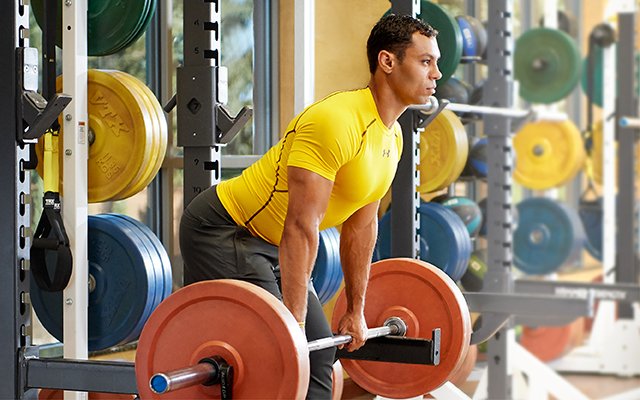Study those around you at the gym and you may notice that many fitness enthusiasts come from one of two camps.
Camp No. 1: Hardcore exercisers believe they must run, jump, push, lift, heave, crunch, sweat, reach and grunt until they’ve beaten themselves into an aching, exhausted, runny-nosed, sleep-deprived, moody, limping ghost of their former selves — and then bang out 20 more pushups. They’re at the gym every day.
Camp No. 2: These laid-back, social types chatter away during their strolls on the treadmill and as they move from one Nautilus machine to another, always keeping the weights on the lightest settings. They never furrow a brow, scrunch their faces, get flushed or break the slightest sweat. They show up to exercise every once in a while, when life doesn’t get in their way.
Whom do you emulate? The ideal answer to that question, of course, is “neither.” Those hardcore exercisers in Camp No. 1 are probably overdoing it, inflicting the kind of unnecessary pain that raises their risk of injury and that may, in the long run, make them weaker. Camp No. 2? They’re not pushing themselves enough to boost their heart rate or stimulate muscle growth.
As it turns out, becoming a fitter person requires that you strike a delicate balance between the hardcore mentality of those in the first group and the easygoing mindset of those in the second. “Exercise is about challenging the body to do what it normally does not,” says Robyn M. Stuhr, an exercise physiologist and sports medicine program director at UC San Diego Health Systems. “At the same time, taking on too much too soon is one of the most common reasons patients end up in the offices of sports doctors.”
Cyclical Logic
You can make slow, modest fitness gains just by gradually increasing the demands you place on your body. But it’s unlikely you’ll ever reach your fitness summit this way. And if you’re determined never to feel a moment’s discomfort, glacially slow results can frustrate you before you make much progress.
Pushing yourself to the edge of your current limits is the fastest (and many would say most satisfying) way to become stronger, faster and more flexible. But if you’re going to go this route, which will require enduring a little discomfort, you must also allow your body the rest and relaxation it needs to build back up for your next hard effort.
Exercise physiologists call this hard-easy approach the “stress-recovery cycle.” It works like this: When you exercise at an intensity level or for a duration that your body isn’t used to, you stress your body by creating small tears in your muscles. Depending on the workout, you also stress your bones, heart and nerves.
Your recovery — the easy days or days off between your intense sessions — allows your body the time it needs to adapt to the stress. After your adaptation is complete, you become stronger. As a result, exercise becomes easier, and previously intense levels of exertion become more comfortable.
During your recovery time after weight training, for example, your body patches muscle tears, fills muscle cells with more protein, and causes the long, thin cells in your muscles to grow thicker and stronger. Your nerves learn to communicate more effectively with your muscle cells, allowing the muscle to recruit more cells during each contraction, says Mark A. W. Andrews, PhD, associate professor of physiology at Lake Erie College of Osteopathic Medicine in Erie, Pa.
After cardiovascular exercise, the mitochondria — the part of a cell that breaks down fat and carbohydrates for fuel — multiply. Your body also builds more capillaries, the tiniest blood vessels, to your muscles. Your fat-burning enzymes increase, allowing your muscles to turn fat into fuel during subsequent exercise. Over time, your heart beats more strongly and pumps more blood with each beat.
Stretching is a slightly different animal than cardio and weight training. When you stretch, your muscles and the connective tissue around them lengthen and stay that way for a certain amount of time after you finish. As the hours pass, your muscles eventually return to their previous state, unless you stretch them again.
“Your muscles are very pliable,” Andrews says. “When you stretch, you are actually working the connective tissue that wraps your muscles and tendons. You can stretch connective tissue every day.” But don’t do cold, static stretching right before a workout, since it has been shown to decrease performance. (For an effective, dynamic-stretching preworkout warm-up, visit “The Perfect Warm-Up.”)
For stretching, cardio and weightlifting sessions to be effective, you must challenge your body with an appropriate level of stress. Overstress your body, and you may end up with a pulled muscle. Understress your body, and it won’t adapt. Finding that edge is the key to executing an effective and sustainable fitness program.
The Right Stress
Your mental edge is that preconceived notion of what your body is capable of doing. Your physical edge is what your body can actually do.
“If you want to excel at something athletically, you have to push yourself and get comfortable with a certain degree of discomfort,” says Scott Fisher, director of the fitness center at Fairleigh Dickinson University in Teaneck, N.J. “This requires just as much mental training as physical training.”
Most people peter out on the mental edge long before they reach their physical edge, especially in the weight room. That’s a shame, because by tolerating just a few moments of discomfort in each workout, they could be getting a whole lot more out of the hours they spend at the gym.
For maximum muscle growth, you must exercise to the brink of muscle failure, the point that requires you to activate every single muscle fiber as you squeeze out one final lift. Only this stimulus is enough to get the maximum number of muscle fibers to break down, and then, after adequate recovery, build back up thicker and stronger. While you don’t have to lift to total failure to achieve strength gains, the further you back away from that edge, the slower progress you’ll make.
In a study published in the Journal of Strength and Conditioning Research, researchers asked novice weightlifters to choose a weight that they felt would improve their strength. The exercisers consistently chose weights that were too light, and they performed too few repetitions with those weights. “They were picking a light weight and doing 10 reps when they needed to do 30 to fatigue the muscle enough to cause muscle growth,” says Steve Glass, PhD, one of the study’s authors and a professor in the Department of Movement Science at Grand Valley State University in Allendale, Mich.
Most of us are somewhat better at pushing ourselves to our aerobic edge. In another study, Glass concluded that most fitness enthusiasts exercise at 55 to 60 percent of their peak heart rate, an intensity high enough to stimulate cardiovascular conditioning. If, in addition to building cardiovascular health, you also want to lower your body-fat percentage, you’ll need to push it to about 75 percent of your peak heart rate for 30 minutes several times a week.
The body’s ability to burn fat varies from person to person. There are a few effective ways to determine your peak heart rate see “The A.T. Factor,” but the most accurate is the VO2-max test. From the test results, you’ll be given heart-rate-training zones for maximizing fat loss and cardiovascular conditioning.
For stretching, you’ll find your edge sooner than you think. Unlike building strength and cardiovascular fitness, increasing flexibility can happen with a fairly mild stimulus. In fact, if you overstretch — and go beyond your edge — you risk getting tighter. (For tips on approaching and respecting your fitness limits, see “Testing Your Limits: A How-to Guide,” below.
The Right Recovery
No matter how much you zero in on your edge during your workouts, all will be for naught if you don’t give yourself enough time to recover between hard efforts. The key is giving your body adequate rest without backpedaling into couch-potato status.
Finding this balance depends on the type of stress you subjected your body to in the first place. For weight training, when you push your muscles to their ultimate limit, you need 48 to 72 hours of complete rest. For cardio, on the other hand, the rules of recovery are a little more flexible. If you’re a runner, you might go for a walk or a light jog on a rest day. Or you might cross-train, switching to non-weight-bearing exercise, such as swimming or cycling.
To make sure you’re giving yourself the right recovery often enough, monitor how you feel after your workouts. Do you have soreness that won’t go away? Do your legs feel tired and heavy? Have you hit a plateau with your results? Are you tossing and turning at night? Are you getting one cold after another? Do you feel tired when you first wake up in the morning? These are indications that your body is not adapting and that it needs
more rest.
Factors other than exercise will influence how much and what type of rest you need. Emotional stress takes a toll on your body, too. If you are stressed at work, for example, your fitness recovery will likely take longer.
Value of Nonviolence
Going beyond your edge with killer workouts that make you limp around for three or more days will raise your risk of lasting injury and can actually hamper your athletic development.
That said, once or twice a year you can and should take your body to places it has never been. Completing your first triathlon, hiking Peru’s Machu Picchu, or competing in a multiday adventure race may require you to rest afterward for a week or more. Yet these types of events provide an emotional high and an expanded sense of your own athletic potential. In short, occasionally beating yourself to a pulp and living to tell about it can infuse your training, and even your life, with new motivation.
Still, you can find your edge anywhere. In fact, some of the best edge-finding lessons come from the mellow and contemplative teachings of yoga.
In his essay “A Nonviolent Approach to Extending Your Limits,” psychologist Ken Dychtwald, PhD, puts it this way: “If I never explore my limits, my bodymind will gradually tighten and become unconscious. If I regularly explore my limits in a caring and adventuresome fashion, I will expand and grow in a vital fashion. But if I try to push myself past where I am honestly able to go . . . I will probably be met by pain and disease.”
Whether you’re a yogi, a gym rat, a competitive athlete or a total fitness newbie, those are wise words to live by.
How to Test Your Body’s Physical Limits
To reach your edge during a strength, cardio or stretching session, you have to listen to your body. That may mean taking off the headphones, turning off the TV or ceasing to chat with the guy or gal on the next treadmill. Become mindful of the very sensations you are trying to ignore, then tune in to what happens next.
Finding Your Weight-Training Edge
Finding your weightlifting edge is simple: Lift the weight until you absolutely cannot lift it even one more time. Ideally, you’ll reach muscle failure in eight to 12 repetitions.
Determining the right weight for failure takes some trial and error. To start, pick a weight and do as many reps as you can, says Steve Glass, PhD, a professor in the Department of Movement Science at Grand Valley State University in Allendale, Mich. If you are lifting and lowering long past a count of 12, the weight is too light. During your next session, go to the next heavier weight, until you can do only 12 or fewer repetitions.
Start each session with a warm-up set, where you lift a lighter weight, stopping short of your failure point. Then do one or two heavy sets that completely fatigue the muscle group you are working. How many heavy sets you complete depends on your goals.
“In your first set of 12 repetitions, you get 80 percent of your strength gains. On your second set, you reach a much smaller percentage, and on a third set, even less,” says Nancy Naternicola, fitness and wellness director at West Virginia University’s College of Physical Activity and Sports Sciences. So if you want to lose some weight and tone up, one hard set is all you need. But if you want to maximize your strength and build your endurance, smaller gains from a second or third set may be worth the extra time.
After your session, give your muscles 48 to 72 hours of rest. “Forty-eight hours of rest is minimal for most people,” says Mark A. W. Andrews, PhD, associate professor of physiology at Lake Erie College of Osteopathic Medicine in Erie, Pa. The harder you pushed it during your session, the longer your body needs to recover. Additionally, consider the following:
- If strength is your goal, lift weights before doing cardio. Otherwise you’ll be spent before lifting.
- Strengthen each major muscle group (arms, shoulders, chest, back, legs) twice a week.
- Follow a lifting schedule (such as chest and shoulders on Monday, arms and legs on Wednesday, and so on, or alternate days of full-body movement), but deviate from that schedule or rest if you feel pain in a muscle.
- Never sacrifice form. You’ll get better gains by pushing hard without caving to sloppiness.
Finding Your Cardiovascular Edge
Unlike in weight training, you won’t push yourself to your cardiovascular edge during every single workout. Rather, adopt a hard-easy approach where you max your limit one day and follow up with a light day or day off.
To find your edge on your hard day, aim to exercise just below your anaerobic threshold or AT (also called your lactate threshold or LT) for part of your workout. When exercising just under your threshold, your breathing will be regular — not labored. You will feel some discomfort, but not so much that you break form or limp. You’ll know you are nearing your threshold if your breathing and heart rate suddenly increase even though you haven’t increased the effort. This means lactic acid and hydrogen ions are building up in your muscles and blood. (For more on finding and working with your
anaerobic threshold, see “The A.T. Factor.”)
To train just under your threshold, add an interval workout to your schedule. Go hard in 30- to 60-second bursts. After each one, take a break, recover and then try another. During each burst, experiment by nearing your threshold, slowing down once your heart starts to race, and speeding up again once you get your heart rate and breathing under control.
After each hard workout, give yourself a 36- to 48-hour break. During this time you can perform light exercise, cross-train, or take a day or two off. On a light training day, you should be able to recite the Pledge of Allegiance while exercising without huffing. You should not, however, be able to sing the national anthem. If you can, your easy days are too easy.
The right combination of hard and easy days varies by person, so practice the subtle art of listening to the cues your body gives you: When you feel sore, take the day off, go easy or cross-train. Don’t jump right back into a hard run, swim or bike ride.
Monitor your heart rate before you get out of bed each morning. “Your heart rate is a great indicator of your cardiovascular fitness,” says Scott Fisher, director of the fitness center at Fairleigh Dickinson University in Teaneck, N.J. “As you become more fit, your morning heart rate will go down. If you overtrain, however, it will go up.” If your heart rate is 10 beats per minute higher than normal, take a day off.
Take one day off each week. If you find you are not recovering well, consider adding another rest day to your schedule.
This article originally appeared as “Finding Your Fitness Edge.”




This Post Has 0 Comments